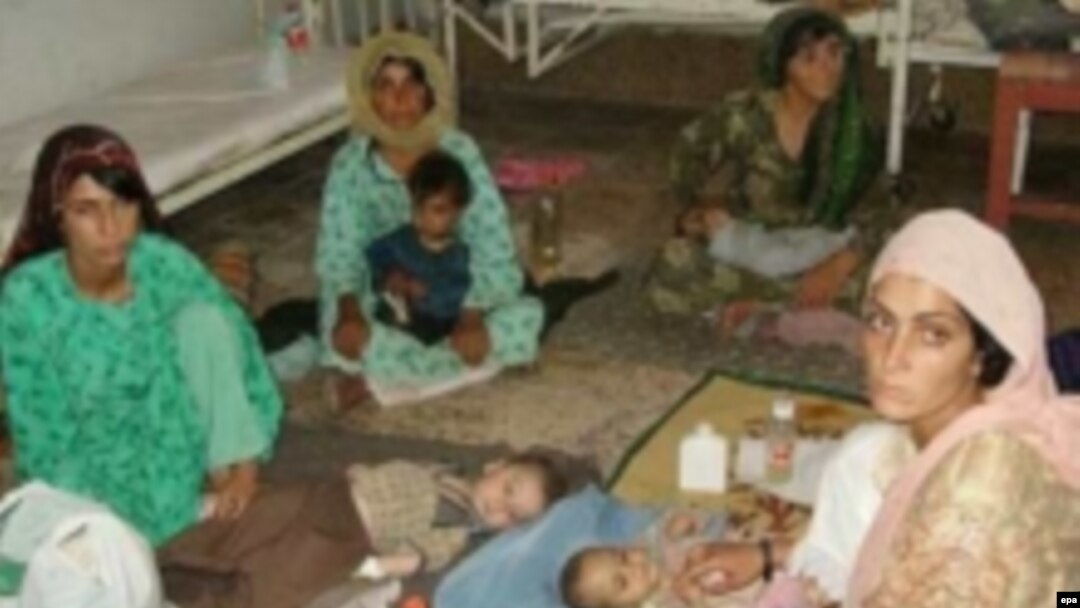PRAGUE, May 10, 2006 (RFE/RL) -- Golandam recently gave birth in her mud house in a village in the eastern province of Nangarhar.
There was no doctor or midwife to assist the young mother. Golandam and her newborn baby died of complications from the childbirth.
A neighbor spoke about her plight with RFE/RL's Afghan Service.
Tragic Deaths
"Most families are concerned about [the health of pregnant women and their babies during delivery]," she said. "My poor neighbor -- even though she had already given birth to three children -- she died while giving birth to the fourth one. When the time of delivery came we went there, she went through a difficult delivery, the placenta remained in the womb, she lost her life and left three children behind."
Golandam's case is not unusual.
Nongovernmental organizations estimate that every 30 minutes a woman dies in Afghanistan from causes related to being pregnant. Only 16 percent of pregnant women in Afghanistan receive prenatal care.
Sixty out of every 1,000 Afghan newborns die and one child in four dies before reaching the age of five.
Save the Children's senior health adviser, Regina Keith, tells RFE/RL that one of the main reasons for the high fatality rates among mothers and their newborns is that many women give birth at home without any professional help.
No Help With Childbirth
"One of the reasons is that so many of the births in Afghanistan occur at home," Keith said. "In other words, we know that if you have a skilled attendant delivering your baby, the likelihood of that child dying, for example, from not being able to breath or [from] infection is [lower]. So, one of the factors is the number of women accessing health [care] for delivery or within the first week of [the] life [of the baby]."
Nadereh Hayat Borhan, an official with Afghanistan's Health Ministry, says most infants die of diseases that can be prevented by simple immunizations and sanitary practices.
"Most of the children's deaths occur because of diarrhea and respiratory infections," Borhan said. "Unfortunately, more than 70 percent of our children die of preventable and treatable diseases."
Illiteracy, poverty, and a crippled or even nonexistent health system are among the factors contributing to the high death rates of infants and mothers in Afghanistan.
Most hospitals and health facilities lack equipment and professional staff. It is estimated that there is only one doctor per 50,000 inhabitants.
Harmful Beliefs
Cultural practices in the deeply conservative and patriarchal Afghan society also contribute to the fact that Afghanistan remains one of the worst places for a woman to give birth.
Especially in rural areas, men often do not allow their female relatives to be treated by male doctors.
Keith says the situation can be improved through simple and affordable solutions including increasing awareness about the importance of proper hygiene and breastfeeding for infants.
"We need to invest more in ensuring that girls and women can have access to more effective education; that they are properly nourished, because we know that one of the biggest causes [of death] is low birth weight," Keith said. "So the health of the mother is really important. Access to health care, access to decision-making responsibilities so that they can do that."
She says such measures have led to better health indicators for mothers and children in northern Afghanistan. Other measures are also being taken.
Health workers are being trained -- including many women nurses and midwives -- to serve in remote areas.
New Hope
In April, a modern pediatric hospital, the French Medical Institute for Children (FMIC), was founded by two French charities (La Chaine de L'Espoir and Enfants Afghans) and was officially inaugurated.
Children from all over Afghanistan are being treated at the hospital, which has about 100 beds, four operating rooms, a laboratory, a pharmacy, and a radiology unit.
More than 120 children have already undergone operations at the hospital and in early April a team of French doctors performed the first open-heart operation, on a young Afghan girl aged 13.
Dr. Fatima Mohpatali is the director for professional support at the FMIC. She tells RFE/RL that the best way to tackle maternal and child mortality in Afghanistan is to develop local abilities.
"People are trying both the NGO community, [the government], the universities -- all are trying," Mohpatali said. "But to reach up to the international standards it requires time and it requires resources. The best way to reach that level would be to develop the capacities of [the] local community here and that is what many NGOs are trying."
She says Afghanistan still has a long way to go before the critical situation for mothers and children improves.
(RFE/RL Afghan Service correspondent Sultan Sarwar contributed to this report.)
RFE/RL Afghanistan Report
SUBSCRIBE For regular news and analysis on Afghanistan by e-mail, subscribe to "RFE/RL Afghanistan Report."


